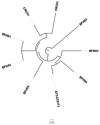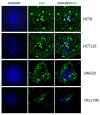Differential Responses of Colorectal Cancer Cell Lines to Enterococcus faecalis' Strains Isolated from Healthy Donors and Colorectal Cancer Patients
- PMID: 30897751
- PMCID: PMC6463247
- DOI: 10.3390/jcm8030388
Differential Responses of Colorectal Cancer Cell Lines to Enterococcus faecalis' Strains Isolated from Healthy Donors and Colorectal Cancer Patients
Abstract
The metabolites produced by the host's gut microbiota have an important role in the maintenance of intestinal homeostasis, but can also act as toxins and induce DNA damage in colorectal epithelial cells increasing the colorectal cancer (CRC) chance. In this scenario, the impact of some of the components of the natural human gastrointestinal microbiota, such as Enterococcus faecalis (E. faecalis), at the onset of CRC progression remains controversial. Since under dysbiotic conditions it could turn into a pathogen, the aim of this study was to compare the effect of E. faecalis' strains (isolated from CRC patients and healthy subjects' stools) on the proliferation of different colorectal cells lines. First, we isolated and genotyping characterized the Enterococcus faecalis' strains. Then, we analyzed the proliferation index (by 3-(4,5-Dimethylthiazol-2-yl)-2,5-Diphenyltetrazolium Bromide (MTT) assay) of three tumor and one normal intestinal cell lines, previously exposed to E. faecalis strains pre-cultured medium. Stool samples of CRC patients demonstrated a reduced frequency of E. faecalis compared to healthy subjects. In addition, the secreted metabolites of E. faecalis' strains, isolated from healthy donors, decreased the human ileocecal adenocarcinoma cell line HCT-8 and human colon carcinoma cell line HCT-116 cell proliferation without effects on human colorectal adenocarcinoma cell line SW620 and on normal human diploid cell line CLR-1790. Notably, the metabolites of the strains isolated from CRC patients did not influence the cell growth of CRC cell lines. Our results demonstrated a new point of view in the investigation of E. faecalis' role in CRC development, which raises awareness of the importance of not only associating the presence/absence of a unique microorganism, but also in defining the specific characteristics of the different investigated strains.
Keywords: Enterococcus faecalis; bacterial metabolites; colorectal cancer; gut microbiota; tumor cell lines.
Conflict of interest statement
The authors declare no conflict of interest.
Figures




Similar articles
-
The controversial role of Enterococcus faecalis in colorectal cancer.Therap Adv Gastroenterol. 2018 Jun 26;11:1756284818783606. doi: 10.1177/1756284818783606. eCollection 2018. Therap Adv Gastroenterol. 2018. PMID: 30013618 Free PMC article. Review.
-
A newly isolated probiotic Enterococcus faecalis strain from vagina microbiota enhances apoptosis of human cancer cells.J Appl Microbiol. 2014 Aug;117(2):498-508. doi: 10.1111/jam.12531. Epub 2014 May 28. J Appl Microbiol. 2014. PMID: 24775273
-
Association of oncogenic bacteria with colorectal cancer in South China.Oncotarget. 2016 Dec 6;7(49):80794-80802. doi: 10.18632/oncotarget.13094. Oncotarget. 2016. PMID: 27821805 Free PMC article.
-
Assessment of oncogenic role of intestinal microbiota in colorectal cancer patients.J Gastrointest Cancer. 2021 Sep;52(3):1016-1021. doi: 10.1007/s12029-020-00531-8. Epub 2020 Oct 3. J Gastrointest Cancer. 2021. PMID: 33009628
-
The Role of the Gut Microbiota in Colorectal Cancer Causation.Int J Mol Sci. 2019 Oct 24;20(21):5295. doi: 10.3390/ijms20215295. Int J Mol Sci. 2019. PMID: 31653078 Free PMC article. Review.
Cited by
-
Colorectal Tumour Mucosa Microbiome Is Enriched in Oral Pathogens and Defines Three Subtypes That Correlate with Markers of Tumour Progression.Cancers (Basel). 2021 Sep 25;13(19):4799. doi: 10.3390/cancers13194799. Cancers (Basel). 2021. PMID: 34638284 Free PMC article.
-
Vaginal Lactobacilli and Vaginal Dysbiosis-Associated Bacteria Differently Affect Cervical Epithelial and Immune Homeostasis and Anti-Viral Defenses.Int J Mol Sci. 2021 Jun 17;22(12):6487. doi: 10.3390/ijms22126487. Int J Mol Sci. 2021. PMID: 34204294 Free PMC article.
-
Combined effects of host genetics and diet on human gut microbiota and incident disease in a single population cohort.Nat Genet. 2022 Feb;54(2):134-142. doi: 10.1038/s41588-021-00991-z. Epub 2022 Feb 3. Nat Genet. 2022. PMID: 35115689 Free PMC article.
-
Gut Microbiome and colorectal cancer: discovery of bacterial changes with metagenomics application in Turkısh population.Genes Genomics. 2024 Sep;46(9):1059-1070. doi: 10.1007/s13258-024-01538-2. Epub 2024 Jul 11. Genes Genomics. 2024. PMID: 38990271
-
Bacterial and Parasitic Pathogens as Risk Factors for Cancers in the Gastrointestinal Tract: A Review of Current Epidemiological Knowledge.Front Microbiol. 2021 Dec 8;12:790256. doi: 10.3389/fmicb.2021.790256. eCollection 2021. Front Microbiol. 2021. PMID: 34956157 Free PMC article. Review.
References
-
- Das Neves F.J., Mattos I.E., Koifman R.J. Colon and rectal cancer mortality in Brazilian capitals, 1980-1997. Arq. Gastroenterol. 2005;42:63–70. - PubMed
-
- Colorectal Cancer Risk Factors. [(accessed on 7 February 2019)];2019 Available online: http://www.cdc.gov/cancer/colorectal/basic_info/risk_factors.htm.
Grants and funding
LinkOut - more resources
Full Text Sources

